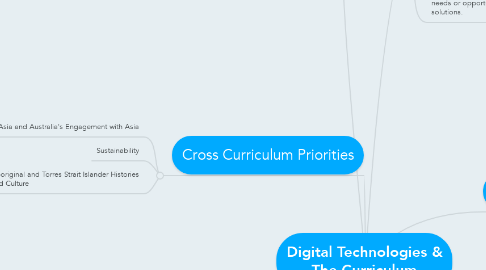
1. Design & Technologies
1.1. Knowledge and Understandings
1.1.1. Technologies and Society
1.1.2. Technologies and Contexts
1.1.2.1. Engineering principles and systems
1.1.2.2. Food and fibre production
1.1.2.3. Materials and technologies specialisations
1.2. Processes and Production Skills
1.2.1. Creating Solutions
1.2.1.1. Investigating and defining
1.2.1.2. Designing
1.2.1.3. Producing and implementing
1.2.1.4. Evaluating
1.2.1.5. Collaborating and managing
2. Cross Curriculum Priorities
2.1. Asia and Australia's Engagement with Asia
2.2. Sustainability
2.3. Aboriginal and Torres Strait Islander Histories and Culture
3. Aims
3.1. Investigate, design, plan, manage, create and evaluate solutions
3.2. Be creative, innovative and enterprising when using traditional, contemporary and emerging technologies, and understand how technologies have developed over time
3.3. Make informed and ethical decisions about technologies
3.4. - Engage confidently with and responsibly select and manipulate appropriate technologies − materials, data, systems, components, tools and equipment − when designing and creating solutions
3.5. - Critique, analyse and evaluate problems, needs or opportunities to identify and create solutions.
4. Digital Technologies
4.1. Knowledge and Understandings
4.1.1. Digital Systems
4.1.2. Representation of Data
4.2. Processes and Production Skills
4.2.1. Collecting, Managing & Analysing Data
4.2.2. Digital Implementations
4.2.3. Creating Solutions
4.2.3.1. Investigating & Defining
4.2.3.2. Designing
4.2.3.3. Producing & Implementing
4.2.3.4. Evaluating
4.2.3.5. Collaborating & Managing
5. General Capabilities
5.1. Literacy
5.2. Numeracy
5.3. ICT
5.4. Critical & Creative Thinking
5.5. Personal & Social
5.6. Ethical Understandings
5.7. Intercultural Understandings
6. Achievement Standards
6.1. Early Childhood (F-3)
6.1.1. By the end of Year 3 - Digital Technologies: - students identify roles people in design and technology have on the community - explore design development processes of products, services and environments. - students observe and recognise ways applied forces and properties of materials affect the behaviour of objects. - students identify equipment and simple processes used in food and fibre production from a range of environments, cultures or time periods. - students select and safely use suitable materials, tools and equipment to create design solutions.
6.1.2. By the end of year 3 - Design and Technology: - students create a sequence of steps to solve a given task - develop and communicate ideas using labelled drawings and appropriate technical terms. - select and safely use appropriate components with given equipment to make a solution. - use criteria to evaluate design processes and solutions developed. - work independently, or collaboratively to plan, safely create and communicate sequenced steps.
6.2. Year 4 - 6
6.2.1. By the end of Year 6: Digital Technologies: - students describe competing considerations in the design of products, services and environments, taking into account sustainability - describe how design and technologies contribute to meeting present and future needs - explain how the features of technologies impact on designed solutions for each of the prescribed technologies contexts
6.2.2. By the end of year 6: Design and Technologies: - students describe competing considerations in the design of products, services and environments, taking into account sustainability - describe how design and technologies contribute to meeting present and future needs - explain how the features of technologies impact on designed solutions for each of the prescribed technologies contexts
